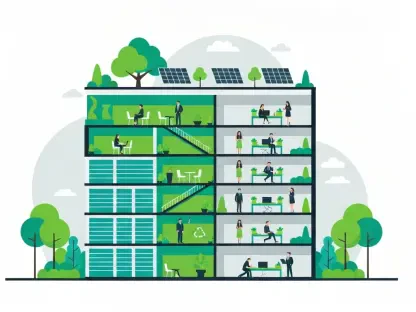The UK’s Build-to-Rent (BTR) sector has experienced remarkable expansion in the last five years, driven by increased interest from developers and investors. This dynamic growth marks a shift from traditional Build-to-Sell (BTS) models to BTR developments, which focus exclusively on constructing residential buildings designed for rental occupancy and managed by a single entity. The transformation within the housing market is evident as BTR becomes an increasingly attractive option for both stakeholders and tenants.
Explosive Growth in BTR
Excellion Capital, a leading debt advisory and investment firm, has illuminated this dramatic surge in BTR, revealing a staggering 173% increase in completed units over the past five years. By the end of 2024, approximately 123,539 BTR homes were completed in the UK, underscoring the rapid evolution and appeal of the sector to developers. This robust growth contrasts sharply with traditional BTS models, highlighting the changing preferences among investors who are now favoring stable, rental-centric approaches.
The substantial rise in BTR properties is not merely a numerical phenomenon but a reflection of strategic shifts within the housing industry. Developers and investors are recognizing the advantages of rental occupancy structures—from streamlined property management to sustainable income flow—which makes BTR a compelling alternative to BTS. Excellion’s data suggests that annual completions have also seen consistent increases, jumping from 10,300 units in 2022 to around 18,000 units in both 2023 and 2024.
London’s Leading Role
London remains at the forefront of this burgeoning BTR market, boasting 54,352 completed BTR homes by the fourth quarter of 2024. This figure illustrates a notable 14.5% annual increase, reinforcing London’s status as a mature and formidable player within the BTR landscape. The city’s established BTR sector not only meets the high demand but also offers attractive returns for investors, thereby solidifying its leading role and setting benchmarks for other regions.
Despite London’s dominance, regional cities are emerging as significant contenders in the BTR arena. The maturation of London’s market demonstrates the viability and profitability of BTR developments, providing a model for expansion beyond the capital. This growth trajectory within London showcases the potential scalability and sustainability of BTR projects, making the sector appealing to investors looking for dependable returns and reduced risk compared to traditional housing models.
Regional Cities on the Rise
While London is currently spearheading the BTR movement, regional cities like Manchester, Newcastle, and Birmingham are rapidly catching up. From Q4 2023 to Q4 2024, these cities have seen a 19.1% increase in completed BTR homes, highlighting significant investment and growth outside London. This regional expansion signals substantial opportunities for investors, with rising demand for quality rental accommodations driving this momentum.
The overall supply increase of 17.1% nationwide suggests that while London’s market is approaching saturation, regional areas offer promising prospects for new BTR developments. Investors are turning their focus to these cities, attracted by their growing markets and potential for high returns. The shifting spotlight to regional cities underscores the diverse investment opportunities within the UK’s BTR sector, promoting balanced urban development and equitable housing solutions.
Attractiveness of BTR Investments
In 2024, the BTR sector garnered an estimated £5.2 billion in investment, with an impressive £1.9 billion in the final quarter alone. This surge in capital influx underscores the strong investor confidence and heightened interest in BTR as lucrative assets. Higher yields relative to the general Private Rented Sector (PRS) also contribute to this attractiveness. London’s average BTR yield stood at 4.93%, which surpasses the PRS market’s 4.45%, indicating more favorable returns for investors.
Such investments reflect the sector’s stability and growth potential, encouraging diversified portfolios. Investors are particularly drawn to BTR for its superior yields, driven by the sector’s focus on quality living and tenant satisfaction. The promise of higher returns combined with the growing demand for rental properties emphasizes the strength and resilience of the BTR market, making it a preferred choice over traditional rental investments.
Superior Yields Across Regions
Regionally, BTR investments exhibit even higher yields, making them incredibly enticing for investors. In the North East of England, yields average 7.65%, establishing a benchmark for profitable BTR ventures. Secondary cities such as Manchester and Newcastle offer yields between 5% and 6%, showcasing strong rental demand and tenant satisfaction that underpin these investment opportunities.
Higher yields can be attributed to the distinctive ethos of BTR developments, prioritizing well-finished properties, longer tenancy agreements, and greater tenant freedom to personalize their homes. Premium amenities like concierges, on-site gyms, and complimentary workspaces further elevate tenant experience, leading to higher occupancy rates and stable returns. These factors create a unique rental environment, justifying premium rents and attracting discerning tenants who value quality living.
Enhanced Tenant Experience
The focus on delivering a superior tenant experience is a hallmark of BTR developments. Properties are often meticulously finished, offering longer tenancy agreements that provide stability and personalization options for tenants. Additional perks like concierges, on-site gyms, and complimentary workspaces enhance the living experience, making BTR properties more desirable in the competitive rental market.
Collaborations with local businesses to offer discounts and deals further increase the attractiveness of BTR developments, fostering community engagement and tenant satisfaction. This strategic approach to tenant experience ensures high occupancy rates and tenant retention, enabling landlords to charge premium rents. The commitment to quality living sets BTR apart from traditional rental options, providing benefits that attract a diverse tenant base willing to invest in better housing standards.
Future Outlook for BTR
The UK’s Build-to-Rent (BTR) sector has seen remarkable growth over the past five years, primarily fueled by a surge in interest from both developers and investors. This rapid expansion signals a significant shift from the traditional Build-to-Sell (BTS) approach, where properties are constructed for sale, to the BTR model, which focuses exclusively on developing residential buildings intended for rental occupancy. These properties are managed by a single entity, ensuring consistency and quality for renters. Consequently, the transformation within the housing market is unmistakable, as BTR developments emerge as a highly attractive option for both stakeholders and tenants. The BTR model not only caters to the needs of modern renters by offering professionally managed properties, but it also provides a reliable investment avenue for developers and investors. The trend indicates that as more people seek flexible living arrangements without the burden of home ownership, the demand for BTR properties will continue to rise, further solidifying its place in the housing industry.









